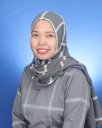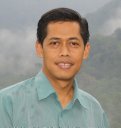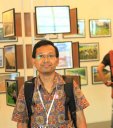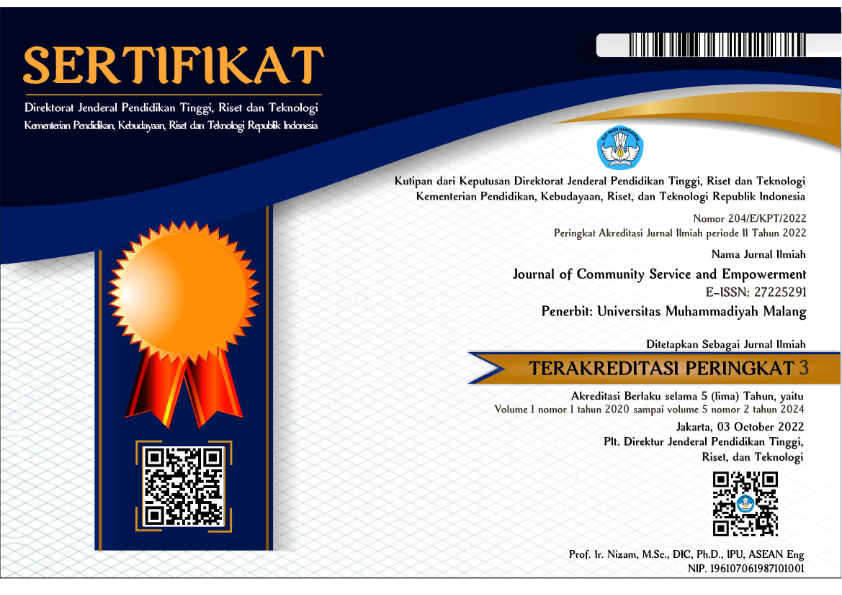Dissemination of instructional book on catfish cultivation: An effort for illiteracy eradication in minapolitan area
DOI:
https://doi.org/10.22219/jcse.v1i1.11513Keywords:
catfish cultivation, illiteracy eradication, instrcutional book, minapolitan areaAbstract
Probolinggo Regency has a low literacy rate (78.09%) which is below the average of the East Java Province (88.34%). This data is supported by the recapitulation results of the Directorate of Literacy and Equality Education in 2014 which states that the illiteracy rate in Probolinggo Regency is 64.163 people. Meanwhile, this regency is considered having a high potential in the field of fisheries through catfish farming, located in Sumberasih District. This article discusses the results of the dissemination of illiteracy eradication using instructional book of catfish cultivation. The empowerment method implemented was Empowerment and Development. The instruments used were interview, observation, document, questionnaire, and test. On trial phase, a mentoring was done to the learning community that was called WB. Prior to the mentoring session, pretest was implemented then posttest afterwards which were all done to the WB. Results show that there was an improvement on class average grade, previously it was 58,5 subsequently after the use of illiteracy eradication book, the average grade has improved to 79. The responses gathered from the WB towards the instructional book were very positive. Thus, instructional book of catfish cultivation can be used as a textbook in illiteracy tutorial in minapolitan area.Downloads
References
Al Adawiyah, R. (2018). Efektifitas buku pembelajaran budidaya lele pada warga buta aksara di Kabupaten Probolinggo (Thesis). University of Muhammadiyah Malang. Retrieved from http://eprints.umm.ac.id/38764/
Bahri, A., & Corebima, A. D. (2015). The contribution of learning motivation and metacognitive skill on cognitive cearning outcome of students within different learning strategies. Journal of Baltic Science Education, 14(4), 487–500. Retrieved from http://search.ebscohost.com/login.aspx?direct=true&db=eue&AN=109884227&%5Cnlang=ko&site=ehost-live
Barton, B. (2007). Making sense of ethnomathematics: Ethnomathematics is making sense. In Stepping Stones for the 21st Century (pp. 225–255). Brill Sense. http://doi.org/10.1007/BF00143932
Cholily, Y. M., Ekowati, D. W., Hakim, R. R., Artadana, I. B. M., & Sumarsono, P. (2017). Illiterate tutorial in minapolitan zone. Energy Education Science and Technology Part B: Social and Educational Studies, 9(4), 181–188. Retrieved from http://eprints.umm.ac.id/37699/20/Cholily Ekowati Hakim Artadana Sumarsono - Tutorial Iliterate Minapolitan.pdf
Dehaene, S., Cohen, L., Morais, J., & Kolinsky, R. (2015). Illiterate to literate: behavioural and cerebral changes induced by reading acquisition. Nature Reviews Neuroscience, 16(4), 234–244. http://doi.org/10.1038/nrn3924
Dwidayati, N. (2018). Pengintegrasian Etnomatematika Dalam Pembelajaran Berbasis Masalah. In PRISMA, Prosiding Seminar Nasional Matematika (Vol. 1, pp. 516–521). Retrieved from https://journal.unnes.ac.id/sju/index.php/prisma/article/view/20135
Ekowati, D. W. (2017). Ethnomathematica: Pembelajaran Matematika dalam perspektif budaya. Semnas Pendidikan Matematika UMM 2017, 163–171. Retrieved from http://research-report.umm.ac.id/index.php/semnasmat/article/view/1040
Griffin, P., & Care, E. (2015). Assessment and teaching of 21st century skills. London: Springer Dordrecht Heidelberg. http://doi.org/10.1007/978-94-017-9395-7
Haryanto, T., Nusantara, S., & Rahardjo, S. (2016). Etnomatematika Arfak: Numerasi Masyarakat Arfak. In Prosiding Seminar Nasional Pendidikan Matematika dengan tema” Pengembangan 4C’s dalam Pembelajaran Matematika: Sebuah Tantangan dalam Pengembangan Kurikulum Matematika (pp. 368–375). Retrieved from https://www.researchgate.net/publication/326546301_Etnomatematika_Arfak_Papua_Barat-Indonesia_Operasi_Bilangan_pada_Perniagaan_Masyarakat_Arfak_Masa_Lalu
Herman, M. C., Wardani, N. K., Muhabbatillah, S., & Purwasih, J. H. G. (2019). Sekolah “emak-emak” untuk buta huruf di Kecamatan Leces Kabupaten Probolinggo. Jurnal Pendidikan Ilmu Sosial, 28(2), 11–16. Retrieved from http://journals.ums.ac.id/index.php/jpis/article/view/7243/4330
Hoekstra, A., & Korthagen, F. (2011). Teacher learning in a context of educational change: informal learning versus systematically supported learning. Journal of Teacher Education, 62(1), 76–92. http://doi.org/10.1177/0022487110382917
Husamah, H., Fatmawati, D., & Setyawan, D. (2018). OIDDE learning model: Improving higher order thinking skills of biology teacher candidates. International Journal of Instruction, 11(2). http://doi.org/10.12973/iji.2018.11217a
İlhan, I. (2014). A study on the efficacy of project-based learning approach on Social Studies Education: Conceptual achievement and academic motivation. Educational Research and Reviews, 9(15), 487–497. http://doi.org/10.5897/err2014.1777
Kahar, M. S., Ibrahim, I., Rusdi, A., & Sukmawati, S. (2019). Pemberdayaan Masyarakat Papua di Distrik Bikar Kabupaten Tambrauw melalui pemberantasan buta aksara. CARADDE: Jurnal Pengabdian Kepada Masyarakat, 2(1), 129–138. http://doi.org/10.31960/caradde.v2i1.275
Kozol, J. (2011). Illiterate america. Garden City, New York: Doubleday. Retrieved from https://www.amazon.com/Illiterate-America-Jonathan-Kozol/dp/0452262038
Lailiyah, U. B. (2017). Pengembangan modul buta aksara untuk masyarakat kawasan miniapolitan di Kecamatan Sumberasih Kabupaten Pobolinggo (Thesis). University of Muhammadiyah Malang. Retrieved from http://eprints.umm.ac.id/35647/
Liu, E. Z. F., Lin, C. H., Jian, P. H., & Liou, P. Y. (2012). The dynamics of motivation and learning strategy in a creativity-supporting learning environment in higher education. Turkish Online Journal of Educational Technology, 11(1), 172–180. Retrieved from http://tojet.net/articles/v11i1/11116.pdf
Maton, K. I. (2008). Empowering community settings: Agents of individual development, community betterment, and positive social change. American Journal of Community Psychology, 41(1-2), 4–21. http://doi.org/10.1007/s10464-007-9148-6
Muzdalipah, I., & Yulianto, E. (2015). Pengembangan desain pembelajaran matematika untuk siswa SD berbasis aktivitas budaya dan permainan tradisional masyarakat Kampung Naga. Jurnal Siliwangi Seri Pendidikan, 1(1). Retrieved from http://jurnal.unsil.ac.id/index.php/jspendidikan/article/view/18
Nisa, S. C. (2018). Pengembangan modul tutorial buta aksara menggunakan pembelajaran budidaya ikan lele (Thesis). University of Muhammadiyah Malang. Retrieved from http://eprints.umm.ac.id/42320/
Nugrahani, F., & Hum, M. (2014). Metode penelitian kualitatif. Solo: Cakra Books. Retrieved from http://lppm.univetbantara.ac.id/data/materi/Buku.pdf
Oroujlou, N., & Vahedi, M. (2011). Motivation, attitude, and language learning. Procedia - Social and Behavioral Sciences, 29, 994–1000. http://doi.org/10.1016/j.sbspro.2011.11.333
Pukdeewut, S., Chantarasombat, C., & Satapornwong, P. (2013). Creative thinking development program for learning activity management of secondary school teachers. International Education Studies, 6(12). http://doi.org/10.5539/ies.v6n12p82
Renganathan, S., Karim, Z. A. B. A., & Li, C. S. (2012). Students’ perception of industrial internship programme. Education and Training, 54(2-3), 180–191. http://doi.org/10.1108/00400911211210288
Roman, S. P. (2010). Illiteracy and older adults: Individual and societal implications. Educational Gerontology, 30(2), 79–93. http://doi.org/10.1080/03601270490266257
Scott, C. L. (2015). The futures of kearning 2: What kind of learning for the 21st Century? (No. 14). Ireland. Retrieved from http://unesdoc.unesco.org/images/0024/002429/242996E.pdf
Sugiyono. (2015). Penelitian & pengembangan, research and development. Bandung: Penerbit Alfabeta. Retrieved from https://shopee.co.id/Buku-Metode-Penelitian-dan-Pengembangan-Research-and-Development-Untuk-Bidang-sugiyono-i.27148555.519847065
Yamada-rice, D. (2011). New media, evolving multimodal literacy literacy practices and the potential impact on increased use of the visual mode in the urban environment on young children’s learning. Literacy, 45(1), 32–43. http://doi.org/10.1111/j.1741-4369.2011.00578.x


















